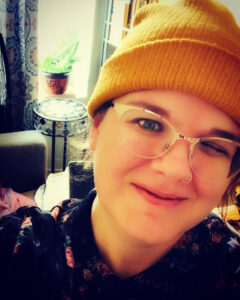This is a weird week–one that straddles two topics, which means there’s a fair amount of reading below!
Let’s finish off the section of focus on style and voice by reading the following poems by Cathy Linh Che and Sheryl Luna. Try to read both of them by Tuesday–I promise you that they’re short!
I hope that our reading the various work of poets shows you a few things: one, that a poem can take multiple forms, and it doesn’t have to follow a structure, two, that the subject of a poem can be about the most mundane and global–sometimes at the same time, and, three, that writing poetry can be frustrating and exhilarating at the same time!
You’ll be able to express your frustrations and exhilarations soon in a journal post, but first, let’s continue with writing dialogue, which we’ll discuss on Thursday (so please read below by then).
On to discussion of dialogue, AKA “hear the bones sing”!
Read the quote from the playwright Suzan-Lori Parks:
So much of African-American history has been unrecorded, dismembered, washed out, one of my tasks as a playwright is to … locate the ancestral burial ground, dig for bones, find bones, hear the bones sing, write it down.
Suzan-Lori Parks
If you’ve ever read a play and then saw it live onstage (or onscreen), you’ll know that a play looks rather–well–boring, especially compared to watching it. It’s just a lot of conversation written with a bunch of indecipherable stage directions. It seems like a bunch of bleached bones–at first glance.

However, when you think about it, bones are pretty important. Without bones, we’d all be a pile of muscle, hair, cartilage, and organs. If you’ve ever broken a major bone, you know that you can be pretty incapacitated while it heals.
Dialogue is the “bones” of so many things–it’s one way we communicate, a way we attempt to share the deepest emotions and the most difficult ideas with the world around us. Parks says that her task as a playwright is to find the “bones” of Black people–a group that has been silenced for centuries by slavery, Jim Crow, and ongoing racism–and “hear the bones sing.” She wants to record the dialogue/bones and let them speak to the world.
By Thursday’s class, I want you to read a monologue of one of Parks’ characters in the play we’re going to read: Lincoln. Read a copy on the Course Profile page titled “Lincoln Monologue, Topdog/Underdog.”
Next, I want you to watch the same monologue on YouTube. Watch it at least twice. Once for familiarity, the second time, I want you to read the text while watching/listening to the video.
By Thursday’s class, I want you to be prepared to discuss the following questions:
- Which did you enjoy/appreciate more–the text or the YouTube video? Why? Be honest and specific!
- When you read the monologue while watching/listening to the video, were you able to read/hear anything you hadn’t noticed before?
- What do you think this play is about, just based on this monologue?
Let’s talk a little about some vocabulary that’s necessary to know when you’re reading scenes from Topdog/Underdog (we’ll be reading scenes in class on Thursday–it’s not homework, but I encourage you to skim the scenes before Thursday).
Rhythm & Pace
Think about music. All music, whether it’s classical, jazz, rock ‘n’ roll, rap, you-name-it, has a rhythm and pace. There are places where it’s fast, slow, medium, etc.
The same can be said about dialogue in a play or a short story. There are moments when someone isn’t speaking that can tell us a lot about a person or what they’re trying to communicate. Just as important as what is said in a dialogue, it’s what isn’t said or how it’s said that’s important.
The comedian Jerry Seinfeld says it well in the following clip I found on YouTube.
Pay attention to the stage directions in the scenes you’re going to read in Topdog/Underdog. I have them below with some explanation.
(Rest)
Take a little time, a pause, a breather; make a transition.
A Spell
An elongated and heightened (Rest). Denoted by repetition of figures’ names with no dialogue. Has sort of an architectural look:
Lincoln
Booth
Lincoln
Booth
This is a place where the figures experience their pure true simple state. While no action or stage business is necessary, directors should fill this moment as they best see fit.
from “Topdog/underdog,” by Suzan-Lori Parks
This is a lot to digest, I know, which is why I encourage you to return to this and read this post more than once! Go to Week 13’s Assignment page and see what’s due this week!





Leave a Reply